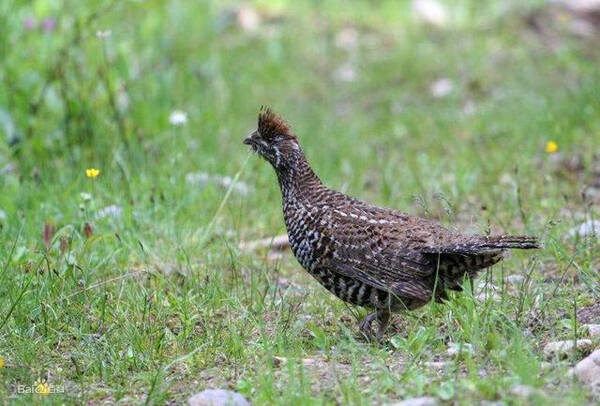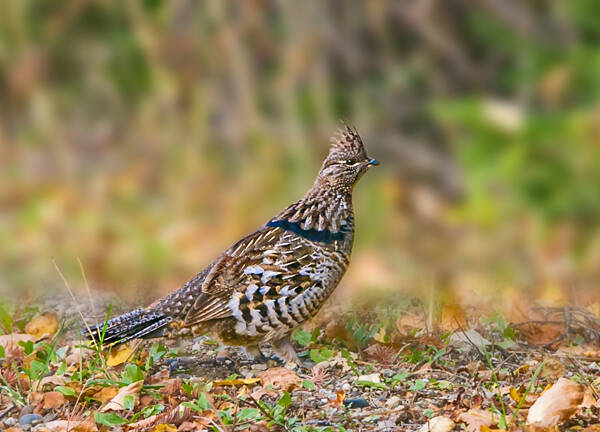Ruffed Grouse
IUCN
LCBasic Information
Scientific classification
- name:Ruffed Grouse
- Scientific Name:Ruffed Grouse,Bonasa umbellus
- Outline:Landfowl
- Family:Gallinomorpha G.family G.Genus
Vital signs
- length:40-50cm
- Weight:450-750g
- lifetime:3-5years
Feature
The male bird has a short crest on its head and a square tail, which has a broad black band toward the tip, fanned out
Distribution and Habitat
Country of origin: Canada, USA. Introduced: Saint Pierre and Miquelon.
In winter, they spend most of their time on the banks of rivers and in mixed forests with coniferous and hardleaf leaves, drilling into the snow cover on the ground overnight, and in other seasons, they often spend their time in pine forests with ferns on the ground and dense undergrowth. In winter, when food is scarce, the range of activity generally expands accordingly.
Appearance
The male is 43-50 cm long and weighs 500-750 g. The female is 40-47 cm long and weighs 450-600 g. Wingspan 55.9-63.5 cm. The feathers are mottled in color and can be gray, brown, hazel and black. The feathers on the lower chest and abdomen are lighter in color. Two color variants exist in this species: the gray form and the red form, and the difference between them is most noticeable on the back of the bird, especially the tail. Taupe species are predominant in northern North America, while red species are predominant in southern North America. Intermediates between these populations are also present.
The shawl hazel has fluffy plumage and the main feature is a short crest on the top of the male's head with a square tail which has a broad black band towards the tip, fanned out. Feathers extend from the forehead to the brown curved beak.
Like other grouse species, the shawl hazel has soft, thin, soft feathers on its legs that cover the ankles, and bare gray-blue claws. In the
Details
The Ruffed Grouse (Bonasa umbellus) has 15 subspecies.

Shawl hazel chicken is a non-migratory bird, is a forest bird, the breeding season is not in groups, other seasons more into small groups of activities, there are 3-4 or 6-7 a group, there are more than 10. Foraging begins at dawn. When looking for food, the flock is scattered, each looking for food, and maintain a certain distance between each other. Usually more hidden in the pine branches, sometimes people go to the nearby, still not moving: in the forest brush slowly, when frightened can run, run a few steps and then take off, sometimes also take off directly, the flight of the two wings agitated very loud, flying quickly, generally flying 2-3 meters that fall on the tree at the low branch, in the people close to take off again. When frightened, they often cling to or hide in branches. In the winter after the heavy snow, they spend more time in the trees, but do not roost in the trees, and spend the night in the snow nests on the ground. The amount of time you spend active each day is closely related to the length of sunrise and sunset.
The cape grouse calls are high and high-pitched, with the same pitch, especially during the breeding season. Connecting with each other with calls will produce a variety of hissing, chirping and peeking sounds.

Shawl hazelchickens are omnivorous pheasants that eat a wide variety of plant foods, insects, and other invertebrates. Includes leaves, buds, seeds and fruits. In winter, the main food source is buds, especially those of poplar and birch trees, which are high in sugar and protein. In the spring, eat new leaves and buds from a variety of plants, including trees, shrubs, and dandelions. In the summer, eat ripe fruits, including blackberries and blueberries. The chicks feed insects and spiders.
The shawl hazel tends to be polygamous, with one male mating with multiple females. Very secluded and very inactive during the breeding season, mating in heat in late April or May. During the breeding period, the position of estrus is similar to that of other birds of the grouse family. The male bird spreads his tail like a fan, hangs his wings, raises his crest, and continuously strokes his wings when running on the ground, often making the ground into shallow trenches. The beginning of estrus is relatively quiet, and when the nest area is basically occupied, there is often a fight between males to prevent other males from entering their nest area. The female does not participate in the fight and is free to forage in any nest. In heat, male and female birds are inseparable, calling to each other. The female is more alert; If there is a sound, they fly away alone, and when it is quiet, they sing to each other again, usually the male flies to the female.
The shawl hazelnut began to nest after mating, and the nest was built in the sunny forest on the hillside, beside the fallen trees or roots on the ground, and also hidden in the forest with more trees and chaotic forest. The nest is very simple and concave. Located in a depression surrounded by many trees. The nest material is dead branches and fallen leaves, and it is lined with fine dry branches, pine needles and hay. The incubation period is about 25 days, and the incubation is performed only by the female bird. The chicks can walk as soon as their feathers are dry, forage independently in a few days, and take off after three weeks.
Listed on the International Union for Conservation of Nature (IUCN) 2016 Red List of Threatened Species ver 3.1 - Not Threatened (LC).
Protect wild animals and eliminate wild meat.
Maintaining ecological balance is everyone's responsibility!








